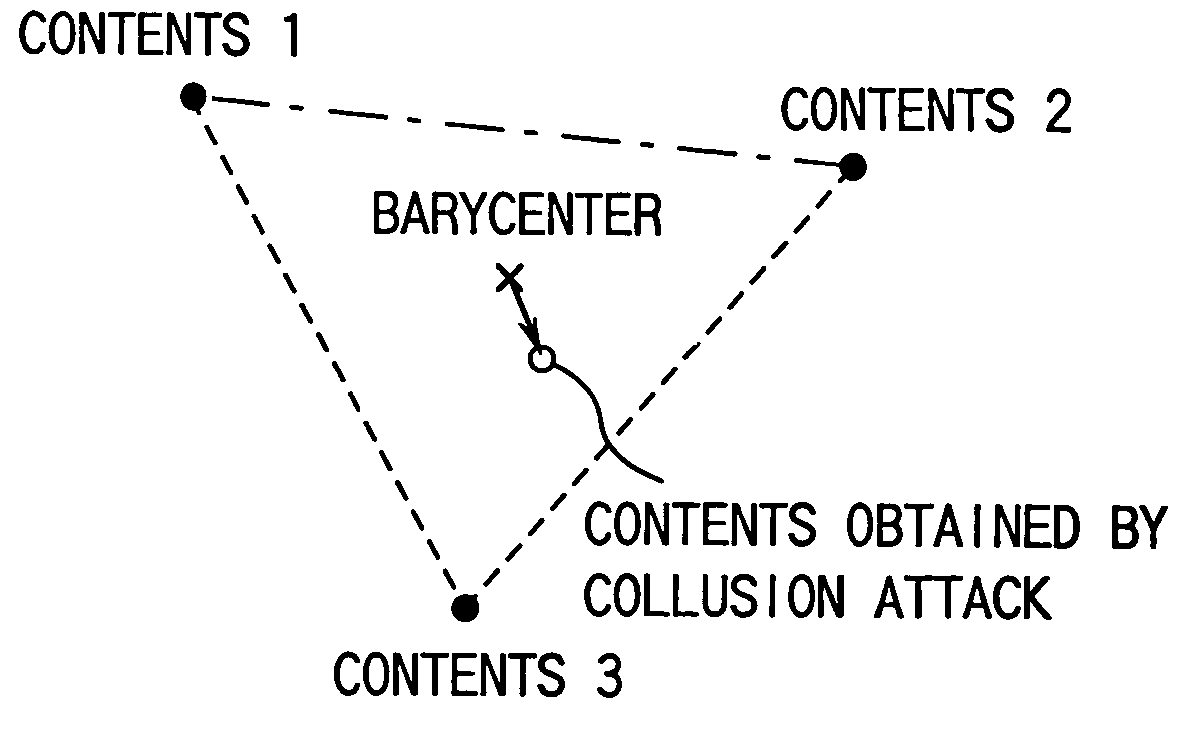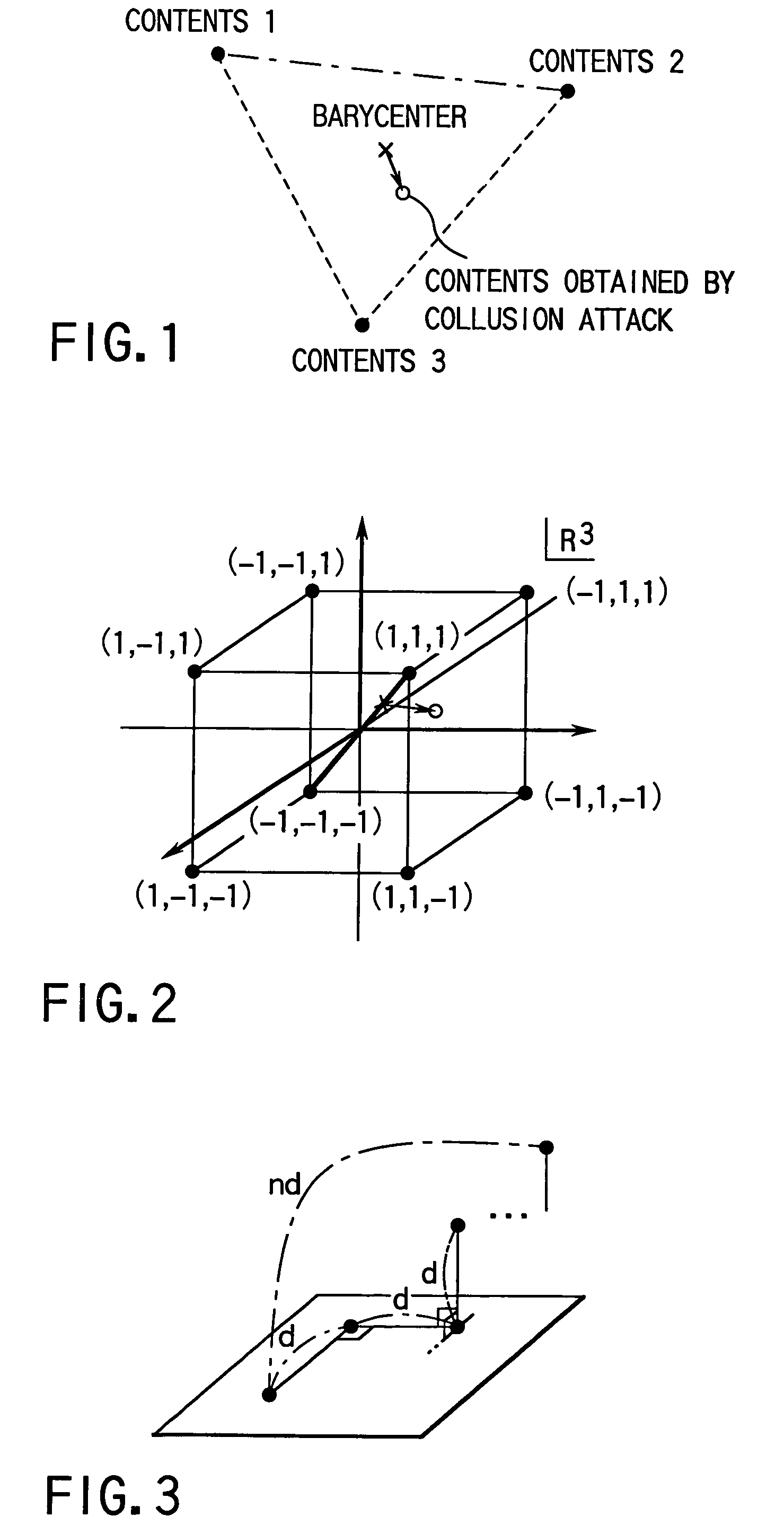Code generating method and unit thereof, code detecting method and unit thereof, and watermark embedding unit and watermark detecting unit
a technology of code generating method and code detecting method, applied in plural information simultaneous broadcast, instruments, television systems, etc., can solve the problems of difficult elimination of watermark information by low-frequency pass filter, information cannot be easily discovered, limited use of contents, etc., to restrict the deterioration of content quality
- Summary
- Abstract
- Description
- Claims
- Application Information
AI Technical Summary
Benefits of technology
Problems solved by technology
Method used
Image
Examples
first embodiment
[0126]A watermark embedding unit and a watermark detecting unit in which a c-secure code with ε-error having a smaller code length than a conventional example is used as an embedded code will be explained as a first embodiment of the present invention.
[0127]FIGS. 6A and 6B show schematic structures of the watermark embedding unit and watermark detecting unit according to the first embodiment of the present invention. The watermark embedding unit shown in FIG. 6A is comprised of a code generating section 11 for generating a code of a user ID to be embedded, which is watermark information to be embedded, and a code embedding section 12 for embedding the generated code into a target content, thereby to obtain a code-embedded content. Meanwhile the watermark detecting unit shown in FIG. 6B is comprised of an embedded-code extracting section 13 for extracting an embedded code from a target content (e.g., a code-embedded content), and an embedded code detecting section 14 for detecting an...
second embodiment
[0226]FIG. 16 shows a structure of a code generating section 11 according to the second embodiment of the present invention. In the code generating section 11 according to the present embodiment, the structure shown in FIG. 7 is added with a user ID assigning section 26 for assigning a user ID to user specifying data which specifies a user of contents, and a user-specifying-data / user-ID correspondence table 26 which stores user specifying data and user IDs assigned by the user ID assigning section 26 with correspondence maintained therebetween.
[0227]In the user ID assigning section 26, a user ID is assigned to inputted user specifying data., as described later. The assigned user ID is inputted to the residue calculating sections 22-1 to 22-k′. Also, the user-specifying-data / user-ID correspondence table 27 stores the user specifying data and the assigned user ID.
[0228]As shown in FIG. 17, the user ID assigning section 26 is comprised of a user ID candidate generating section 261, a u...
third embodiment
[0271]FIG. 26 shows the structure of the code generating section 11 according to the third embodiment of the present invention. In the code generating section 11 according to the present embodiment, the structure shown in FIG. 7 is added with a database referring section 28 and a non-weak ID database 29.
[0272]The non-weak ID database 29 stores non-weak IDs among all user ID candidates. The non-weak IDs stored in this non-weak database 29 are obtained in a method similar to the discriminating method in the user ID candidate discriminating section 262 according to the second embodiment, e.g., in a method in which either a weak ID or non-weak ID is discriminated by the algorithm explained with reference to FIG. 19 with respect to all user ID candidates.
[0273]When user specifying data is inputted, the database referring section 28 assigns one non-weak ID stored in the non-weak ID database 29, as a user ID, corresponding to the use specifying data, and outputs the non-weak ID (user ID). ...
PUM
 Login to View More
Login to View More Abstract
Description
Claims
Application Information
 Login to View More
Login to View More - R&D
- Intellectual Property
- Life Sciences
- Materials
- Tech Scout
- Unparalleled Data Quality
- Higher Quality Content
- 60% Fewer Hallucinations
Browse by: Latest US Patents, China's latest patents, Technical Efficacy Thesaurus, Application Domain, Technology Topic, Popular Technical Reports.
© 2025 PatSnap. All rights reserved.Legal|Privacy policy|Modern Slavery Act Transparency Statement|Sitemap|About US| Contact US: help@patsnap.com



